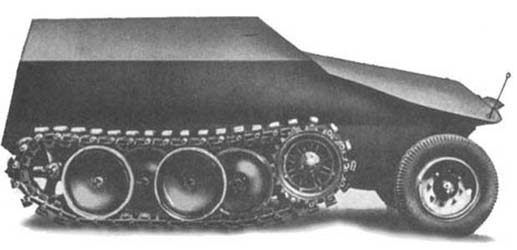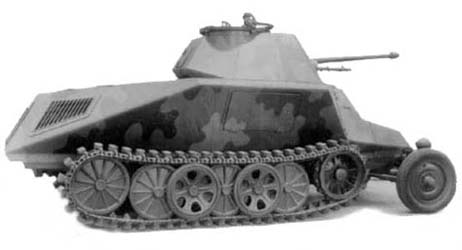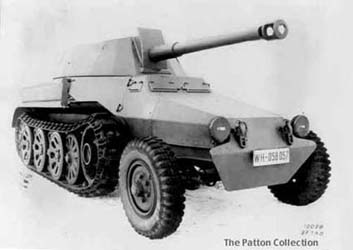/Vehicles/Axis/Germany/08-Halftracks/Others/File/Others.htm | Last Up-date:
Other Halftracks
HKp 603 / 604 / 605 / 606
Dans la production des Sd.Kfz.250 et 251, beaucoup d'efforts font double emploi, car peu d'éléments sont communs aux deux engins. Le modèle léger est trop petit pour certaines fonctions et le modèle lourd trop grand pour d'autres. Il fut donc tenté de rationaliser les half-tracks pour ne conserver qu'un seul modèle. Une série de prototypes, la série HK 600, fut mise au point par Hanomag et Demag en 1942. Ces engins ressemblaient très fort aux modèles de la série Sd.Kfz.251 mais néanmoins la distinction "half-track léger" et "half-track lourd" demeure. Par exemple, le HKp 603 est un half-track lourd alors que le HKp 606 est un modèle léger. La conception est toutefois nettement simplifiée par rapport au Sd.Kfz.251 et 250 mais apportait insuffisamment d'amélioration pour entrer en production. La série sera abandonnée en 1943 mais bon nombre de simplifications seront reprises sur les Sd.Kfz.251 et 250.
In the production of Sd.Kfz.250 and 251, much of efforts make double use, bus few elements are common to both machines. The light model is too small for certain function and the heavy model too large for others. It was thus tempted to rationalize the half-track vehicles to preserve one model. A series of prototype, the series HK 600, will be developed by Hanomag and DEMAG in 1942. These machines resembled very extremely the models of the Sd.Kfz.251 series but nevertheless the distinction "light half-tracked vehicle" and "heavy half-tracked vehicle" remains. For example, HKp 603 is a heavy half-tracked vehicle whereas HKp 606 is a light model. The design however is clearly simplified compared to Sd.Kfz.251 and 250 but insufficiently made improvement to start production. The series will be abandoned in 1943 but considerable simplifications will be taken again on Sd.Kfz.251 and 250.
 |
HKp 606. |
src: Site "Achtung
Panzer"
|
37 mm Selbstfahrlafette L/70
Au début de 1935, le Waffenamt demanda à Rheinmetall-Borsig de développer un canon de 37 mm L/70 automoteur utilisant le châssis de 3t d'Hansa-Lloyd-Goliath ZkWg. L'armement consistait en un canon de 37 mm L/70 et deux mitrailleuses de 7.92 mm MG34 montés dans la tourelle. Un seul prototype fut réalisé à la fin 1936 et fut intensivement testés par les unités de cavalerie
At the beginning of 1935, Waffenamt required to Rheinmetall-Borsig to develop a motorized 37 mm L/70 gun using the chassis of 3t of Hansa-Lloyd-Goliath ZkWg. The armament consisted of a gun of 37 mm L/70 and two machine-gun of 7.92 mm MG34 assembled in the turret. Only one prototype was constructed at the end of 1936 and was intensively tested by the units of cavalry
 |
37 mm Selbstfahrlafette L/70. |
src: Site "Achtung
Panzer"
|
75 mm Selbstfahrlafette L/40.8
En 1934, le Waffenamt commanda une nouveau canon antichar automoteur à Rheinmetall-Borsig, basé sur l'half-track de Büssing-NAG. A partir de 1935, 3 prototypes (Modell 1), qui variaient en poids et en longueur furent mis au point en quelques années. En 1936/1938, une nouvelle variante avec frein de bouche et d'autres modifications fut réalisée (Modell 2).
In 1934, Waffenamt ordered a new motorized anti-tank gun to Rheinmetall-Borsig, based on the half-tracedk vehicle of Büssing-NAG. From 1935, 3 prototypes (Modell 1), which varied in weight and in length were developed in a few years. In 1936/1938, a new alternative with muzzle brake and other modifications were carried out (Modell 2).
 |
 |
75 mm Selbstfahrlafette L/40.8 (Modell 1). |
75 mm Selbstfahrlafette L/40.8 (Modell 2). |
src: Site "Achtung
Panzer" |
src: Site "Achtung
Panzer" |
[75 mm Selbstfahrlafette L/40.8 (Modell 2) Drawings]
Drawings |
Sources:
- Site "Achtung Panzer" - http://www.achtungpanzer.com
- Site "WWII Vehicles" - http://www.wwiivehicles.com
- Site "Second World War Armour" - http://www.onwar.com/tanks/index.htm